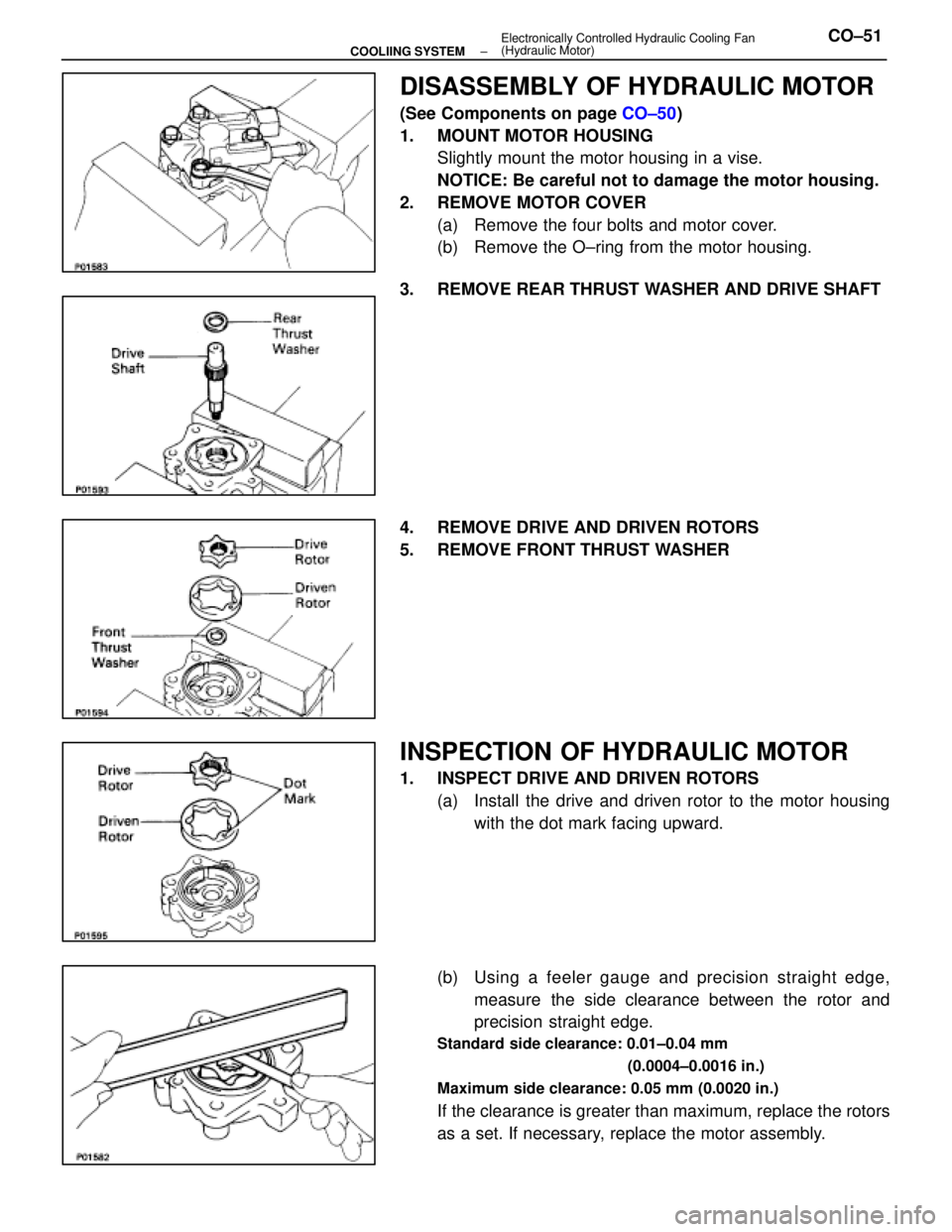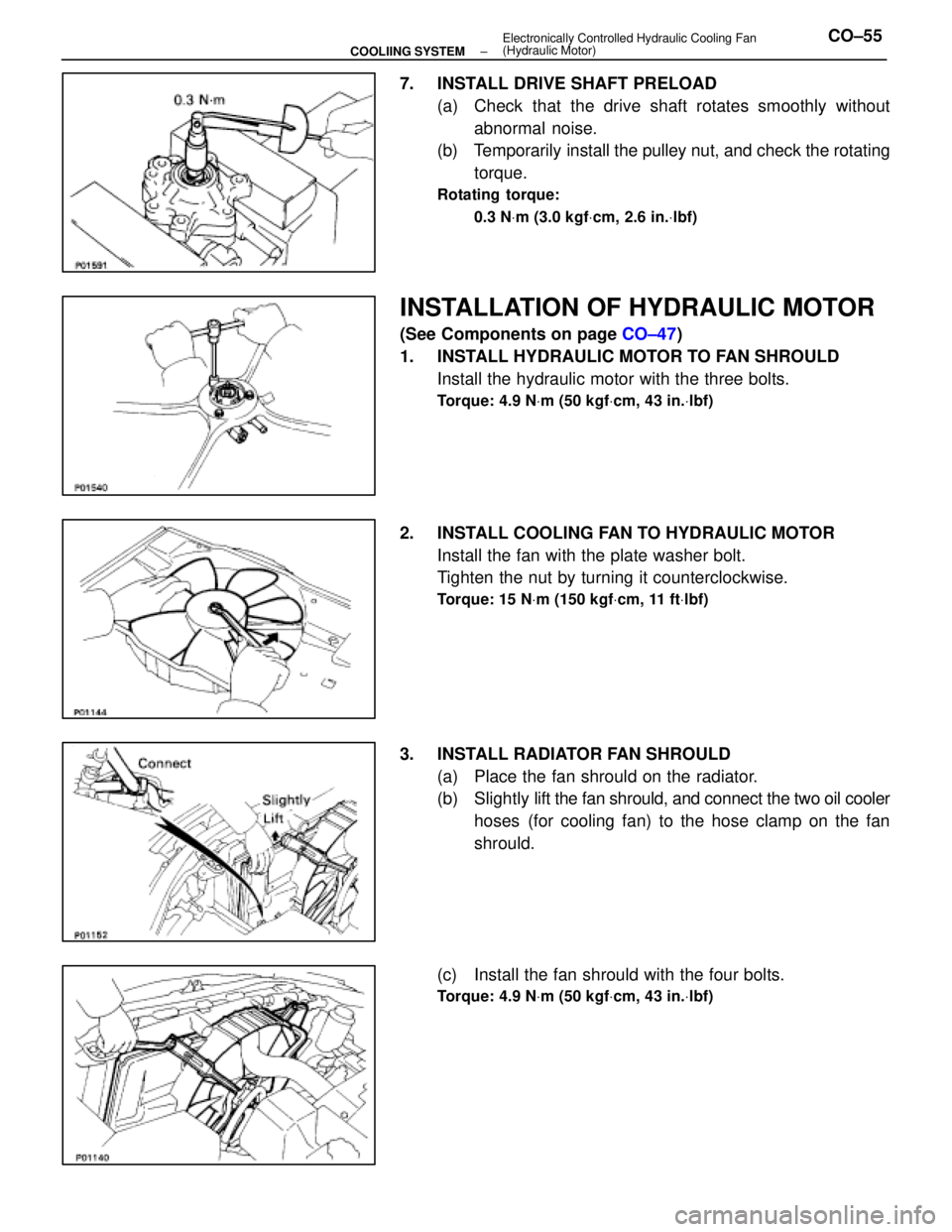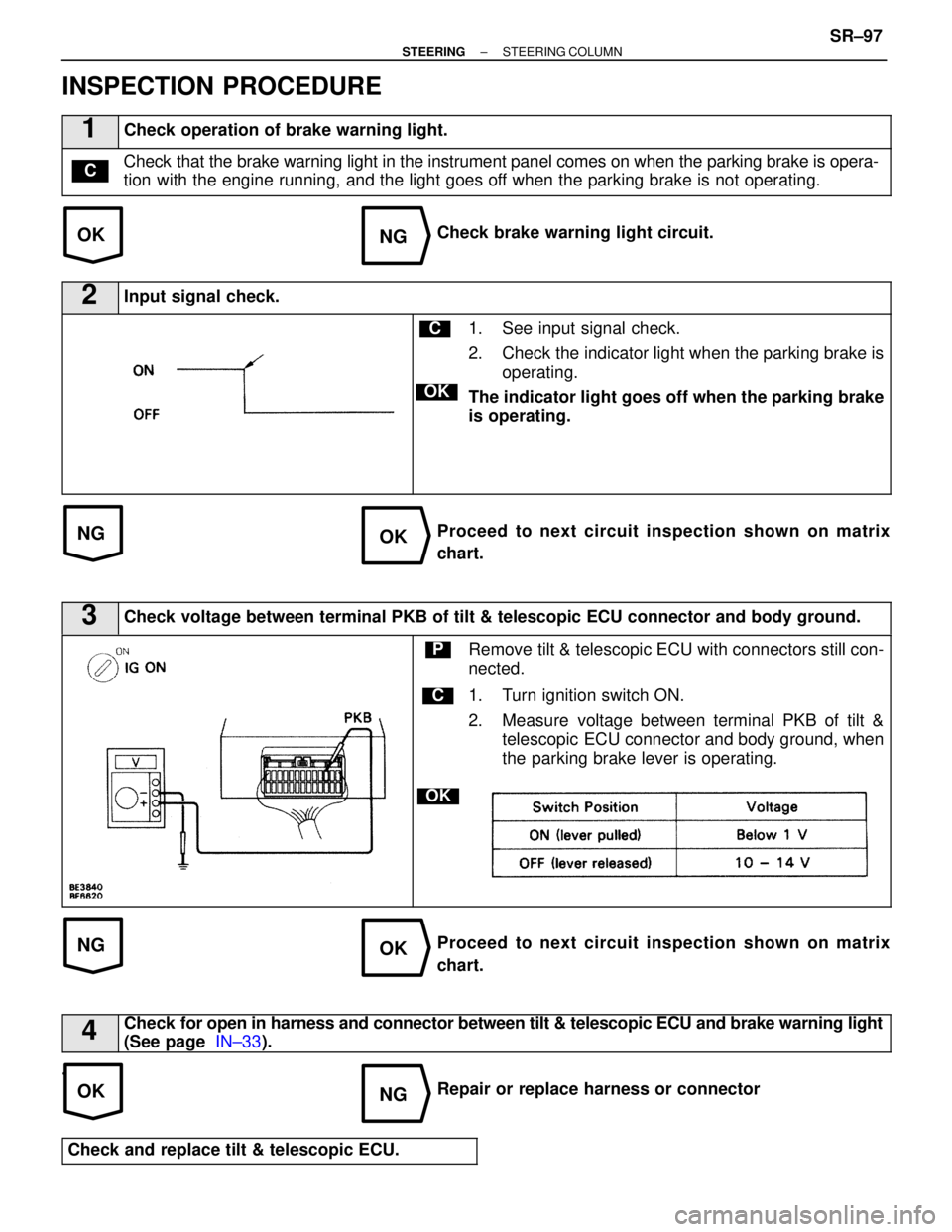Page 2835 of 4087
6. DISCONNECT COOLING FAN INLET PIPE FROM FANSHROULD
Remove the two bolts, brackets and bushings, and discon-
nect the inlet pipe.
7. DISCONNECT COOLING FAN RESERVOIR TANK FROM FAN SHROULD
(a) Disconnect the suction hose from the clamp on the fanshrould.
(b) Remove the four bolts, and disconnect the reservoir tank.
8. REMOVE RADIATOR FAN SHROULD (a) Disconnect the wire clamp (for temperature sensor)from the radiator fan shrould.
(b) Remove the four bolts, and disconnect the fan shrould from the radiator.
(c) Slightly lift the fan shrould, and disconnect the two oil cooler hoses (for cooling fan) from the hose clamp on
the fan shrould.
(d) Remove the fan shrould.
±
COOLIING SYSTEM Electronically Controlled Hydraulic Cooling Fan
(Hydraulic Motor)CO±49
WhereEverybodyKnowsYourName
Page 2837 of 4087

DISASSEMBLY OF HYDRAULIC MOTOR
(See Components on page CO±50)
1. MOUNT MOTOR HOUSING Slightly mount the motor housing in a vise.
NOTICE: Be careful not to damage the motor housing.
2. REMOVE MOTOR COVER (a) Remove the four bolts and motor cover.
(b) Remove the O±ring from the motor housing.
3. REMOVE REAR THRUST WASHER AND DRIVE SHAFT
4. REMOVE DRIVE AND DRIVEN ROTORS
5. REMOVE FRONT THRUST WASHER
INSPECTION OF HYDRAULIC MOTOR
1. INSPECT DRIVE AND DRIVEN ROTORS (a) Install the drive and driven rotor to the motor housingwith the dot mark facing upward.
(b) Using a feeler g auge and precision straight edge,
measure the side clearance between the rotor and
precision straight edge.
Standard side clearance: 0.01±0.04 mm
(0.0004±0.0016 in.)
Maximum side clearance: 0.05 mm (0.0020 in.)
If the clearance is greater than maximum, replace the rotors
as a set. If necessary, replace the motor assembly.
±
COOLIING SYSTEM Electronically Controlled Hydraulic Cooling Fan
(Hydraulic Motor)CO±51
WhereEverybodyKnowsYourName
Page 2840 of 4087
ASSEMBLY OF HYDRAULIC MOTOR
(See Components on page CO±50)
HINT:
w Thoroughly clean all parts to be assembled.
w Before installing the parts, apply new fluid to all sliding
and rotating surfaces.
1. MOUNT MOTOR HOUSING Slightly mount the motor housing in a vise.
NOTICE: Be careful not to damage the motor housing.
2. INSTALL FRONT THRUST WASHER
3. INSTALL DRIVEN AND DRIVE ROTORS Install the d rive and driven rotors with the dot mark facing up-
ward.
4. INSTALL DRIVE SHAFT
5. INSTALL REAR THRUST WASHER
6. INSTALL MOTOR COVER (a) Install a new O±ring to the motor housing groove.
(b) Install the motor cover with the four bolts.
Torque: 28 N Vm (290 kgf Vcm, 21 ft Vlbf)
CO±54±
COOLIING SYSTEM Electronically Controlled Hydraulic Cooling Fan
(Hydraulic Motor)
WhereEverybodyKnowsYourName
Page 2841 of 4087

7. INSTALL DRIVE SHAFT PRELOAD(a) Check that the drive shaft rotates smoothly withoutabnormal noise.
(b) Temporarily install the pulley nut, and check the rotating
torque.
Rotating torque:
0.3 N Vm (3.0 kgf Vcm, 2.6 in. Vlbf)
INSTALLATION OF HYDRAULIC MOTOR
(See Components on page CO±47)
1. INSTALL HYDRAULIC MOTOR TO FAN SHROULD Install the hydraulic motor with the three bolts.
Torque: 4.9 N Vm (50 kgf Vcm, 43 in. Vlbf)
2. INSTALL COOLING FAN TO HYDRAULIC MOTOR
Install the fan with the plate washer bolt.
Tighten the nut by turning it counterclockwise.
Torque: 15 N Vm (150 kgf Vcm, 11 ft Vlbf)
3. INSTALL RADIATOR FAN SHROULD
(a) Place the fan shrould on the radiator.
(b) Slightly lift the fan shrould, and connect the two oil cooler
hoses (for cooling fan) to the hose clamp on the fan
shrould.
(c) Install the fan shrould with the four bolts.
Torque: 4.9 N Vm (50 kgf Vcm, 43 in. Vlbf)
±
COOLIING SYSTEM Electronically Controlled Hydraulic Cooling Fan
(Hydraulic Motor)CO±55
WhereEverybodyKnowsYourName
Page 2886 of 4087

The 1 UZ±FE engine has 8±cylinders in a V±arrangement at a bank an\
gle of 905. From the front of the RH
bank cylinders are numbered 2±4±6±8, and from the front of the LH b\
ank cylinders are numbered 1 ±3±5±7.
The crankshaft is supported by 5 bearings specified by the inside of the cr\
ankcase. These bearings are made
of a copper and lead alloy. The crankshaft is integrated with 8 weights which are cast along with it\
for balancing. Oil holes are built
into the center of the crankshaft for supplying oil to the connecting ro\
ds, pistons and other components. The ignition order is 1±8±4±3±6±5±7±2. The cylinder\
head is made of aluminum alloy, with a cross flow
type intake and exhaust layout and with pent±roof type combustion chambers. The spark plugs are loca\
ted in
the center of the combustion chambers.
At the front and rear of the intake manifold, a water passage has been p\
rovided which connects the RH
and LH cylinder heads. Exhaust and intake valves are equipped with irregular pitch springs made\
of special valve spring carbon
steel which are capable of following no matter what the engine speed.
The RH and LH intake camshafts are driven by a single timing belt, and a ge\
ar on the intake camshaft en-
gages with a gear on the exhaust camshaft to drive it. The camshaft jour\
nal is supported at 5 (intake) or 4 (ex-
haust) places between the valve lifters of each cylinder and on the front end of the cylinder \
head. Lubrication
of the cam journal gear is accomplished by oil being supplied through the \
oiler port in the center of the camshaft. Adjustment of the valve clearance is done by means of an outer shim type\
system, in which valve adjusting
shims are located above the valve lifters. This permits replacement of the sh\
ims without removal of the cam-
shafts. Pistons are made of high temperature±resistant aluminum alloy, and a depression is built into the piston
head to prevent interference with valves.
Piston pins are the full±floating type, with the pins fastened to neither the piston boss nor the connecting
rods. Instead, snap rings are fitted on both ends of the pins, preventing the\
pins from falling out. The No.1 compression ring is made of steel and the No.2 compression ring\
is made of cast iron. The oil
ring is m ade of a combination of steel and stainless steel. The outer diameter of\
each piston ring is slightly larger
than the diameter of the piston and the flexibility of the rings allows them\
to hug the cylinder walls when they
are mounted on the piston. Compression rings No.1 and No.2 work to prevent \
the leakage of gas from the cylin-
der and the oil ring works to scrape oil off the cylinder walls to prevent it from entering the combustion chamber. The cylinder block is made of aluminum alloy with a bank angle of 90 5. Cast iron cylinders are installed
inside the cylinder block. It has 8 cylinders which are approximately twice the length of th\
e piston stroke. The
top of each cylinder is closed off by the cylinder heads and the lower end of the cylinders becomes the crank-
case, in which the crankshaft is installed. In addition, the cylinder bl\
ock contains a water jacket, through which
coolant is pumped to cool the cylinders. The No.1 and No.2 oil pans are bolted onto the bottom of the cylinder block\
. The No.1 oil pan is made of
aluminum alloy. The No.2 oil pan is an oil reservoir made of pressed steel sheet. An o\
il level sensor is installed
in the No.1 oil pan (If the oil level drops below a set level, a warnin\
g light lights up.). A oil pan baffle plate keeps
sufficient oil in the bottom of the No.2 oil pan even when the vehicle is tilted. \
This dividing plate also prevents
the oil from making waves when the vehicle is stopped suddenly and the oil \
shifts away from the oil pump suction
pipe. Plastic region tightening bolts are used for the cylinder head, main bearing ca\
p and connecting rod.
EM±4
±
ENGINE MECHANICAL Operation
WhereEverybodyKnowsYourName
Page 2955 of 4087
OKNG
NGOK
INSPECTION PROCEDURE
1Check shift position indicator.
Check that ªPº lights up on the shift indicator when P position is shif\
ted into, and that ªPº is extin-
guished when shifting into another position.P
Check and repair shift position indicator circuit (See
page BE±168 ).
2Check voltage between terminal P of ECU connector and body ground.
C
OK
PRemove ECU with connectors still connected.
1. Turn ignition switch on.
2. Measure voltage between terminal P of ECU con-
nector and body ground when the shift lever is oper-
ated.
Proceed to next circuit inspection shown on matrix chart
(See page SR±52).
Check for open in harness and connectors be-
tween ECU and [IK1] connector.
±
STEERING STEERING COLUMNSR±95
WhereEverybodyKnowsYourName
Page 2957 of 4087

OKNG
NGOK
NGOK
OKNG
INSPECTION PROCEDURE
1Check operation of brake warning light.
Check that the brake warning light in the instrument panel comes on when the \
parking brake is opera-
tion with the engine running, and the light goes off when the parking brake is not operating.C
Check brake warning light circuit.
2Input signal check.
C
OK
1. See input signal check.
2. Check the indicator light when the parking brake isoperating.
The indicator light goes off when the parking brake
is operating.
Proceed to next circuit inspection shown on matrix
chart.
3Check voltage between terminal PKB of tilt & telescopic ECU connector and bod\
y ground.
C
OK
PRemove tilt & telescopic ECU with connectors still con-
nected.
1. Turn ignition switch ON.
2. Measure voltage between terminal PKB of tilt & telescopic ECU connector and body ground, when
the parking brake lever is operating.
Proceed to next circuit inspection shown on matrix
chart.
4Check for open in harness and connector between tilt & telescopic ECU and brak\
e warning light
(See page IN±33).
.
Repair or replace harness or connector
Check and replace tilt & telescopic ECU.
±
STEERING STEERING COLUMNSR±97
WhereEverybodyKnowsYourName
Page 2959 of 4087
OKNG
NGOK
INSPECTION PROCEDURE
1Check operation of door courtesy light LH.
Check that door courtesy light comes on when the driver's door is opened, and that the light goes
off when the driver's door is closed.P
Check and repair door courtesy light circuit.
2Check voltage between terminal DSW of ECU connector and body ground.
C
PRemove ECU with connectors still connected.
Measure voltage between terminal DSW of ECU con-
nector and body ground when the driver's door is
opened and closed.
Proceed to next circuit inspection shown on matrix chart
(See page SR±52).
Check for open in harness and connector between
ECU and door courtesy switch LH connector.
±
STEERING STEERING COLUMNSR±99
WhereEverybodyKnowsYourName